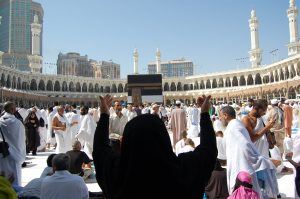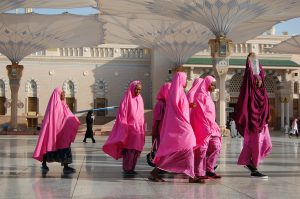“A Sinner in Mecca” (2015, 2020 re-release). Cast: Parvez Sharma. Director: Parvez Sharma. Screenplay: Sajid Akbar, Alison Amron and Parvez Sharma. Web site. Trailer.
When faced with a paradox, it’s easy to lose hope. Circumstances may seem so inextricably entangled that it appears there’s no way to sort matters out. Indeed, it’s the kind of situation where it seems like only divine intervention can help. And it’s that kind of help that’s being sought by a seriously conflicted individual whose hopes, dreams and aspirations are caught up in a conundrum ostensibly incapable of being unraveled, the subject of the recently re-released documentary, “A Sinner in Mecca.”
After the completion of his controversial debut feature, filmmaker Parvez Sharma became a marked man. In 2008, the gay Islamic director released the documentary “A Jihad for Love,” which detailed the lives and struggles of homosexual Muslims around the globe. His action earned him a fatwa, a religious opinion that condemned him for the crime of apostasy. Even though he was living in the relative safety of New York, this proclamation hung heavily over him for what was considered such an outwardly blasphemous cinematic statement.
However, this condemnation was not about to stop Sharma from speaking out. He made numerous media appearances to discuss his film and draw attention to the plight of gay Muslims, who often face persecution and severe punishment for their “crimes,” including public beheadings in countries like Saudi Arabia, homeland of the faith. This ascent of his public profile made his personal security even more perilous, a problem potentially complicated further when he married his partner, Dan, when same-sex marriage became legal in the US. But this was not to be the end of his exploits in pushing the envelope.
Even though Sharma could be openly comfortable about his sexuality in his secular life in the US, he faced considerable challenges when trying to be himself in a religious context. And faith was not something that the filmmaker took casually. Having been born and raised in India, he grew up in a rich religious tradition, devoutly practicing his faith and adhering to the loving, accepting traditions at the core of Islam. However, in an age when the faith had been hijacked by fundamentalist extremists who distorted many of the religion’s teachings and imposed vile punishments for infractions, all for their own archaic and misogynist ends, it often caused him and countless other peace-loving Muslims to alter their behavior for fear of dangerous reprisals. Here he was, a 21st Century man attempting to live under the dictates of 700-year-old religious laws and doctrines.
[caption id="attachment_11587" align="aligncenter" width="350"] Gay Islamic filmmaker Parvez Sharma documents his odyssey to Mecca, Saudi Arabia for his sacred hajj pilgrimage, a journey all Muslims are required to make at least once in their lifetimes, as depicted in the recently re-released documentary, “A Sinner in Mecca.” Photo courtesy of Haram Films.[/caption]
Gay Islamic filmmaker Parvez Sharma documents his odyssey to Mecca, Saudi Arabia for his sacred hajj pilgrimage, a journey all Muslims are required to make at least once in their lifetimes, as depicted in the recently re-released documentary, “A Sinner in Mecca.” Photo courtesy of Haram Films.[/caption]
This placed Sharma in the middle of a confounding paradox: How could he be both an open and authentically gay man while also being a devout Muslim under the prevailing threatening conditions? This was particularly true for his desire to participate in the hajj, a pilgrimage to the Islamic holy city of Mecca, a venture all Muslims are required to complete at least once during their lifetimes. It was something he was anxious to undertake, but how welcome would an openly gay man with a fatwa on his head be made to feel in journeying to Saudi Arabia’s most sacred site?
This was not the only challenge Sharma faced in making his pilgrimage. As a filmmaker, he wanted to document his odyssey, particularly since it would give him an opportunity to share images of Mecca with the outside world. He believed this was important to provide outsiders with a view of Islam’s holiest site, as well as the devotion of pilgrims who make the journey there, especially since non-Muslims are strictly forbidden from visiting the holy city. However, filming of any kind is illegal in Saudi Arabia, so, in attempting to document his journey, Sharma would be taking on an additional risk besides the fatwa already dogging him.
But perhaps the biggest challenge Sharma faced was the one with himself, wrestling with an uneasy conscience seeking to reconcile his innate sexuality with the tenets of the faith he so dearly loved. How could he be a good Muslim if he were living life in a way that inherently went against its principles and traditions? Could he truly be accepted by his Islamic peers for who he was? But, most importantly, would Allah willingly embrace him as one of the faithful if he were violating what he believed to be God’s will? Indeed, could a sacred pilgrimage really answer those questions for him and provide him with inner peace?
[caption id="attachment_11588" align="aligncenter" width="350"] Devoted Muslims making the hajj pilgrimage to Mecca, Saudi Arabia are required to visit the sacred Kabaa shrine at the holy city’s Great Mosque, a ritual gesture depicted in the recently re-released documentary “A Sinner in Mecca,” available for online streaming. Photo courtesy of Haram Films.[/caption]
Devoted Muslims making the hajj pilgrimage to Mecca, Saudi Arabia are required to visit the sacred Kabaa shrine at the holy city’s Great Mosque, a ritual gesture depicted in the recently re-released documentary “A Sinner in Mecca,” available for online streaming. Photo courtesy of Haram Films.[/caption]
Such are the conditions under which Sharma launched into his journey. With one eye perpetually looking over his shoulder, he embarked on his hajj to complete its various required rituals, armed with only an iPhone camera and two other miniature recording devices to capture events as they unfolded. He wasn’t sure what awaited him, but he was certainly hopeful to find the answers he sought.
What Sharma found surprised even him. He found a world to which the faithful from all over the globe devotedly flocked. He found a sense of devotion that was profoundly moving, including for himself. And he witnessed images of a religious following that flew squarely in the face of what much of the outside world saw as being representative of contemporary Islam. He was especially moved by the throngs of pilgrims piously encircling the Kabaa, the massive cube-shaped shrine at the center of the Great Mosque of Mecca and a symbol that has become virtually synonymous with the hajj.
At the same time, though, Sharma also came upon a world he didn’t expect. Given that millions of visitors descend upon Mecca every year, he found elements that surprised and even saddened him – unbridled commercialism, uncontrolled public sanitation issues, insufficient resources for handling the crowds and militarized security to keep pilgrims in check. Was such greed and squalor something that Islam should tolerate in connection with its most sacred rituals? Were the faithful indeed to go without the provision of basic needs? And were gun-toting guards really necessary to shepherd pilgrims through the various aspects of their odyssey? Such elements ran counter to the Islam that Sharma grew up with, leaving him with a sense of disillusionment, despite the obvious need for instituting such substantial logistical requirements for managing crowds of this size.
[caption id="attachment_11589" align="aligncenter" width="350"] Pilgrims from various Islamic sects around the world make their way to Mecca, Saudi Arabia for the hajj, a ritual of faith all Muslims are required to complete at least once in their lifetimes, as chronicled in “A Sinner in Mecca.” Photo courtesy of Haram Films.[/caption]
Pilgrims from various Islamic sects around the world make their way to Mecca, Saudi Arabia for the hajj, a ritual of faith all Muslims are required to complete at least once in their lifetimes, as chronicled in “A Sinner in Mecca.” Photo courtesy of Haram Films.[/caption]
In light of the questions that Sharma had going in to this undertaking, as well as the new ones raised by his journey, he seems to have emerged from the experience with more queries on his plate than what he started with. And sorting them out sufficiently appears to have become even more difficult than expected. So where does one go from here? That depends to a great degree on one’s beliefs and how they’re employed through the conscious creation process, the philosophy that maintains we draw upon these resources in shaping the reality we experience.
It’s unclear whether Sharma has ever heard of or had any experience with conscious creation. However, given that his quandary rests squarely with sorting out his beliefs and what he wants to do with them, his resolution to his issues also seems to depend on the process that makes use of those very same resources in creating something workable from them. So, in light of that, the answers to the many looming questions here would seem to rely on getting one’s belief house in order.
Considering the foregoing, as illustrated in the film, Sharma would appear to have his work cut out for him. To begin with, there’s the fundamental core matter of reconciling his gay life with his religious calling. In accepting his sexuality, he has embraced a significant aspect of his authentic self, despite whatever opposition others may have to his choice to do so. But, in terms of allowing this decision to jibe with his religious self, he’s faced with a bigger question to address: Can he realistically buy into a belief that asks him to willingly deny an integral part of himself in order to be accepted as a proper follower of the religion in which he seeks to participate? The answer to that question would still appear to be in the process of emerging, something that Sharma hoped the hajj would help him determine. How much closer he is to an actual answer by journey’s end, however, is unclear at best.
[caption id="attachment_11590" align="aligncenter" width="350"] The hajj pilgrimage is a moving moment of faith for all Muslims as seen in director Parvez Sharma’s recently re-released documentary, “A Sinner in Mecca.” Photo courtesy of Haram Films.[/caption]
The hajj pilgrimage is a moving moment of faith for all Muslims as seen in director Parvez Sharma’s recently re-released documentary, “A Sinner in Mecca.” Photo courtesy of Haram Films.[/caption]
Then there are the disillusionment beliefs that arose as a result of his pilgrimage, particularly those associated with how well the faith treats its own when making their sacred journey. For instance, Sharma seems to take issue with one of the world’s largest and most lavish shopping malls being located only a stone’s throw away from the Great Mosque of Mecca. Indeed, the very notion of this calls to mind the story of Jesus and the money changers in the temple. Is such close proximity to a sacred site really appropriate for a Starbuck’s? And what does that say about the character of one’s faith – is a religion that sanctions such practices truly worthy of one’s devotion? Has it lost sight of the principles upon which it was founded in favor of secularized, self-serving interests?
Then there are the larger issues of the faith – is it acceptable to throw one’s support behind a religion that has been hijacked by extremists and has willingly cast aside its humanitarianism, leaving the world with a distorted view of what it’s all about at its heart? As a religion claimed by one-sixth of the world’s population, is it acceptable to allow it to be mischaracterized in such a distorted way? Can beliefs along those lines be justified?
These are some of the pressing matters to be resolved, and Sharma, like many others in his shoes, is up against a difficult stack of beliefs to sort out. To that end, though, he proposes a significant idea to consider – that contemporary gay Muslims become involved in bringing the faith into the 21st Century, helping to institute change to a religion that in many ways is still stuck in the 1400s. That’s certainly a noble and pragmatic idea, but, to make it happen, one must invoke beliefs aimed at realizing that outcome. Given that conscious creation makes anything possible, it’s an idea certainly worthy of consideration. But, if it’s going to happen, one must first believe in the possibility, because, after all, that’s what conscious creation is all about.
[caption id="attachment_11591" align="aligncenter" width="350"] Encircling the Kabaa shrine at the Great Mosque of Mecca is an event virtually synonymous with the Islamic hajj pilgrimage, as seen in the recently re-released documentary, “A Sinner in Mecca,” available for online streaming. Photo courtesy of Haram Films.[/caption]
Encircling the Kabaa shrine at the Great Mosque of Mecca is an event virtually synonymous with the Islamic hajj pilgrimage, as seen in the recently re-released documentary, “A Sinner in Mecca,” available for online streaming. Photo courtesy of Haram Films.[/caption]
Back in time for Pride month via online streaming, this highly personal 2015 documentary about a gay Muslim examines the quandary of an individual seeking to be true to himself on diametrically opposed fronts. Questions of attempts at fulfilling sanctioned elements of devotion clash with personal values that run counter to them, pitting the protagonist against himself as he seeks to reconcile feelings for which there are no easy answers. As someone who risks the death penalty for his lifestyle, as well as legal sanctions for engaging in artistic pursuits that are forbidden in Islam’s homeland, director Sharma takes viewers on a journey that captivates, educates and boggles the mind, all at the same time. There are moments when Sharma’s story will leave viewers shaking their heads, as well as occasions when the material seems padded and somewhat self-indulgent. However, if nothing else, this offering will leave audiences with myriad questions about how to sort out personally significant but inherently conflicting circumstances, some of which may be applicable to our own circumstances, whether we’re Muslim or not.
It’s been said that he who tries to serve two masters will be torn asunder. And, when dealing with circumstances whose qualities are worlds apart, that just may be true unless an obviously inventive solution can be found. Thankfully, though, that’s one of the beauties of beliefs; they can be tailored to specifically suit our needs, enabling the most wondrous creations. All we need do is come up with the right combination of attributes to fulfill our requirements and then commit to seeing them realized. The result just may feel heaven sent.
Copyright © 2020, by Brent Marchant. All rights reserved.
Tuesday, June 30, 2020
‘A Sinner in Mecca’ seeks to unravel an entangled paradox
Subscribe to:
Post Comments (Atom)

No comments:
Post a Comment